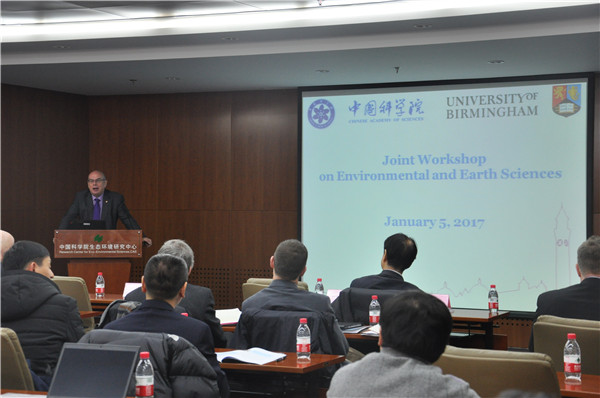UK, China experts come together to battle Beijing's smog
 |
|
Professor Sir David Eastwood, Vice-Chancellor at the University of Birmingham, delivers a keynote speech during the joint workshop between the University of Birmingham and the Chinese Academy of Sciences in Beijing on Jan 5, 2017. [Photo provided to chinadaily.com.cn] |
Researchers at the University of Birmingham have underlined the urgent need for Chinese megacities to identify sources that contribute to the lingering air pollution.
This comes as a consortium of seven UK universities, led by University of Birmingham, aims to address air pollution sources in Beijing. The research project, worth £2.6 million ($3.2 million), is in collaboration with leading Chinese institutes such the Chinese Academy of Sciences (CAS) and Tsinghua University.
Back in December 1952, the Great London Smog killed 4,000 people in the UK. Experts later revised the death toll to more than 12,000. At that time, Londoners were using coal as their main fuel as other energy sources were expensive due to the Second World War.
Despite the different geographic and social settings, Chinese scientists are eager to learn from the lessons London experienced half a century ago.
"The London smog in the 1950s was perhaps easier to deal with than the air pollution in Beijing today," William J. Bloss, Professor of Atmosphere Science at Birmingham, told China Daily website in Beijing. "It is related to the source being largely a single phenomenon of burning dirty coal with high sulfur content in the city for power generation, heating and industries."
"But nowadays we face air pollution problems with small particles and nitrogen dioxide. If we look back to source origins, we can identify industries, power generation, heating, vehicles and agricultural emissions," said Bloss. "It is a mixture of primary pollutants and secondary ones formed in the atmosphere."
"The challenge for Beijing is to understand how all these ingredients come together to generate the haze, and from that we can identify the best emission-control measures to improve the situation," added Bloss.
Launched last January, the project comprises major field observations in Beijing, with the latest one conducted in December. It will then be followed by laboratory and data analysis and numerical model simulations. The research will continue until 2020.
 |
|
Sir David Eastwood, Vice-Chancellor at the University of Birmingham, meets with the press in Beijing on Jan 5, 2017. [Photo provided to chinadaily.com.cn] |
So, after sorting out the pollutants, how could we tackle the problem?
"The first is legislation, namely the Clean Air Act; the second is better science which enables us to embrace newer and cleaner tech; the third is the heavy industries start to decline in the 1960s-70s," said Professor Sir David Eastwood, Vice-Chancellor at the University of Birmingham, reflecting on the three factors that led to the end of the Great London Smog.
"The key lies in the development of clean energy tools to cut coal emissions," said Professor Li Jinghai, former vice-president of CAS."A good case in point is that the new technique CAS has recently developed for rural people in Shandong province to replace the old coal burning boilers with more energy-efficient ones.
An inaugural workshop has been simultaneously launched in Beijing on Thursday for environmental specialists from Birmingham and CAS to discuss further collaboration in areas such as river ecosystems and using fossil research to better understand how past steps can tackle current climate issues.
- China issues alerts for smog, fog
- Heavy smog continues to choke Chinese cities
- Smog leaves tourists stranded on ship
- Heavy fog, smog continue to disrupt traffic in China
- China's schools beat the smog with live-streaming
- Heavy smog suspends schools, causes travel problems
- Heavy smog set to stick around
- Smog prompts 309 flight cancellations in Tianjin
- Smog disrupts travel, triggers alerts




















